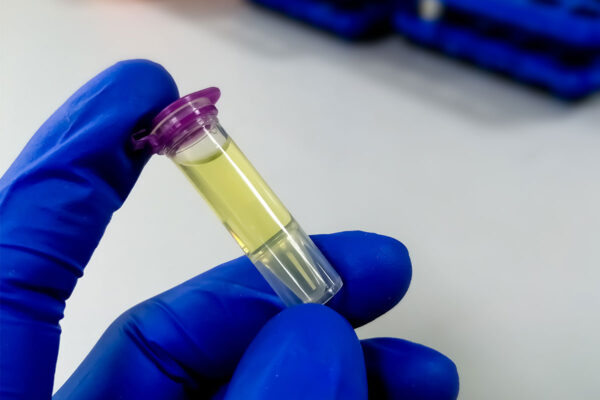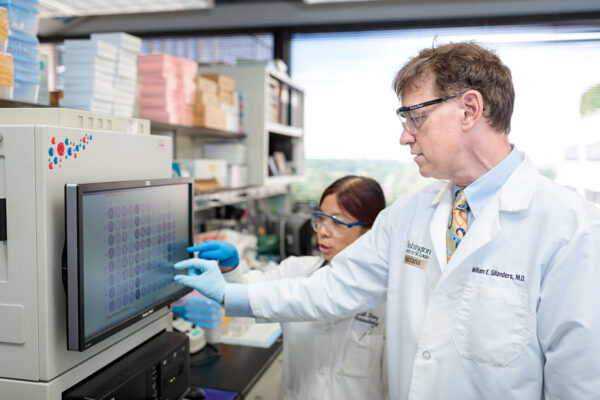In a testament to the quality and national competitiveness of biomedical research at Washington University School of Medicine in St. Louis, the school secured $683 million in research funding from the National Institutes of Health (NIH) in federal fiscal year 2024 — a record high for WashU Medicine and an affirmation of its leadership in shaping the future of medicine.
This support — which places the school at No. 2 in NIH funding nationwide for the second year in a row — enables groundbreaking advances in the understanding, diagnosis and treatment of illnesses and propels its relentless pursuit of improvements in medical care. Over the past eight years, WashU Medicine has been the fastest growing of the top U.S. research-intensive medical institutions in NIH funding.
“Far too much still is unknown about human diseases,” said David H. Perlmutter, MD, executive vice chancellor for medical affairs, the George and Carol Bauer Dean of WashU Medicine, and the Spencer T. and Ann W. Olin Distinguished Professor. “Our research programs are designed to tackle the most vexing questions with state-of-the-art techniques and analytical methods and generate innovative answers that will substantially improve outcomes for our patients. The success in funding and our growth is not, in and of itself, the goal; rather, it is a validation of our progress and the exceptional talent we have cultivated through training and recruitment, and a reminder of the work ahead as we continuously strive to improve patient care. Our true success is measured in the lives transformed and advances in human health. At WashU Medicine, we’re not only advancing research today; we’re building for tomorrow’s breakthroughs.”



Global impact from the heart of the Midwest
Fueled by its unique culture in the heart of the Midwest — where collaboration, creativity and curiosity thrive — WashU Medicine drives innovation and discoveries that shape the future of medicine across the globe. More than 1,000 NIH-funded research projects are underway at the school. Among the projects newly funded this year are efforts to prevent early-onset colorectal cancer; understand why the aging brain becomes susceptible to dementia; develop a gene therapy to potentially cure HIV; improve outcomes and quality of life for children with heart disease; and prepare for the next viral pandemic.
“WashU Medicine has created a remarkably vibrant ecosystem of innovative research, and I’m fortunate to be a part of it,” said Jeffrey I. Gordon, MD, the Dr. Robert J. Glaser Distinguished University Professor and director of the Edison Family Center for Genome Sciences & Systems Biology. “This research is propelled by an extraordinary cadre of talented, imaginative and energetic faculty, students and staff who are deeply committed to finding answers to compelling questions in both basic and clinical research. Our collaborative spirit and deep sense of community, combined with an ability to make timely prioritized investments in people, programs and enabling technology, have fostered a ‘discovery engine’ that enables WashU Medicine researchers to readily cross traditional disciplinary boundaries.”
Gordon, widely regarded as the father of the microbiome, has led pioneering research to develop a treatment for childhood malnutrition that nurtures the beneficial microbes in the gut. The aim is to more effectively treat the condition that is responsible for an estimated 3 million deaths worldwide and complications that include stunted growth, neurological problems and immune system deficiencies. Gordon’s research has been funded continuously by the NIH for more than four decades, and the microbiome-directed therapy he and his collaborators have developed is in clinical trials in South Asia and Africa.
Sustaining the pipeline of medical scientists
In addition to supporting established researchers with a track record of discoveries, NIH also awarded 31 WashU Medicine researchers their first R01 or equivalent grants in 2024. Such grants are designed to fund innovative, rigorous research projects with a high potential impact, and obtaining one represents a vote of confidence by the NIH in a researcher’s abilities as an independent investigator.
“One of the most important accomplishments and biggest challenge for a medical researcher is competing successfully for their first R01,” Perlmutter said. “We track this metric very closely as an indicator of our effectiveness in mentoring and providing the optimal environment, both of which are critical to sustaining a pipeline of medical scientists for the future of our society.”
One such recipient is Jing Hughes, MD, an assistant professor of medicine and of cell biology and physiology, who received a grant to study antennae-like cell organelles, known as primary cilia, on the insulin-producing cells in the pancreas that become damaged in diabetes. Such research is foundational to developing more effective diabetes treatments.
“I was honored to receive my first R01 award this year,” Hughes said. “We know there is an association between primary cilia dysfunction and the development of diabetes, but we really don’t know the full picture. A better understanding of this process could lead to new cilia-based therapeutic approaches to decrease the burden of diabetes in the United States and across the world.”
Discoveries in basic-science labs like Hughes’ translate into better care for patients locally and globally by spurring development of new diagnostics and therapeutics. WashU Medicine values the combined insights and expertise researchers and clinicians bring to solving the world’s most pressing medical challenges.
A bold strategy yields results
When he took the helm at WashU Medicine in 2016, Perlmutter worked with the executive leadership team to establish a strategic vision for expanding the school’s research mission by investing in critical infrastructure, including:
- Construction of new research facilities, which together added nearly 800,000 square feet of research space and is spurring innovative collaborations to advance knowledge and develop new therapies in the coming decades. These include the new Jeffrey T. Fort Neuroscience Research Building, one of the world’s largest devoted exclusively to neuroscience research. The building unites WashU Medicine experts to make discoveries at the frontier of brain science that will alleviate suffering and cure diseases once thought to be incurable. A new six-story addition on the Steven and Susan Lipstein BJC Institute of Health is aimed at enhancing infectious diseases and immunology research as well as programs that can develop novel therapies to treat cancer and other diseases.
- Leveraging large philanthropic gifts like the BJC Investigators Program, designed to recruit top-notch basic scientists, and the Personalized Medicine Initiative initially funded by Centene Corporation and now utilizing institutional funds to provide extensive funding for high-risk, high-impact projects that can deliver new diagnostics and therapeutic strategies in the precision-medicine paradigm on an urgent timeline. Major gifts from James and Elizabeth McDonnell have facilitated the work of the McDonnell Genome Institute in the areas of mass spectrometry-based multi-omics, genomic engineering and translational bioinformatics in collaboration with the Institute for Informatics. Gifts from Phil and Sima Needleman have provided funding for innovations in basic research platforms that have the highest potential to be translated into new technologies and companies.
- Encouraging substantial investments from department chairs across WashU Medicine in the growth of the school’s clinical programs, with the aim of advancing health care in the St. Louis region and supporting the expansion of our research mission.
These large, ongoing investments are buttressed by significant annual financial support for research by WashU Medicine. In 2024, the school spent $376.3 million of its own funding on research, a sum that includes the costs of maintaining shared equipment, facilities and resources, as well as start-up funding for recruits and trainees. By far the largest components of this institutional funding are the salaries of the principal investigators ($167 million) and capital expenses. With this level of institutional funding, together with grants from foundations, donors and other government agencies such as the Centers for Disease Control and Prevention, total research funding at WashU Medicine topped $1.2 billion in 2024, and the returns on that investment are manifold.
“Outside grants only cover about 70% of the cost of doing research,” Perlmutter said. “That figure includes what is called direct costs as well as facilities and administrative (F&A) that are required for the research to be carried out. We cover the rest out of our institutional funds because research is a core mission at WashU Medicine.
“Just in the past few years, the work of WashU Medicine researchers has led to a host of innovations that are improving care. These include the first blood test for Alzheimer’s disease; an inhalable COVID-19 vaccine; a Food and Drug Administration (FDA)-approved drug for a genetic form of amyotrophic lateral sclerosis (ALS); two tests for genetic mutations in blood and solid cancers that aim to improve outcomes by enabling precision medicine approaches to treatment; investigational cellular therapies for childhood and adult leukemia; promising clinical trials evaluating the use of radiation therapy for the treatment of heart failure; and investigational DNA vaccines for triple-negative breast cancer, a type that is extremely challenging to treat. Our research funding enables WashU Medicine scientists to make the discoveries that improve health and wellness for people in St. Louis and beyond and we view the improvement in medical care that comes from this research as our obligation as NIH grantees.”
The ripple effect of NIH funding
WashU Medicine’s NIH-funding success also acts as a magnet for the brightest minds in medicine, drawing top-tier scientists, physicians and students from around the world to work and train at WashU Medicine. The medical students and research trainees who learn their craft at WashU Medicine are part of the next generation of leaders who will make the breakthroughs that will shape medicine for decades to come.
This influx of talent fosters collaborations with biotech and pharmaceutical companies, driving further medical advancements and spurring local and regional economic growth. Every $1 million in research funding creates 11 local jobs, generating opportunities in St. Louis and strengthening WashU’s role as a regional economic engine.
“This achievement belongs not only to the people who work in the lab and the field, but to everyone at WashU Medicine,” Perlmutter said. “Our researchers couldn’t make their discoveries without the doctors and other providers who work directly with patients as part of clinical research and the staff members who support our research mission in myriad ways. We’re one team, united by a shared mission to harness scientific discovery to improve health locally and globally.”
About Washington University School of Medicine
WashU Medicine is a global leader in academic medicine, including biomedical research, patient care and educational programs with 2,900 faculty. Its National Institutes of Health (NIH) research funding portfolio is the second largest among U.S. medical schools and has grown 56% in the last seven years. Together with institutional investment, WashU Medicine commits well over $1 billion annually to basic and clinical research innovation and training. Its faculty practice is consistently within the top five in the country, with more than 1,900 faculty physicians practicing at 130 locations and who are also the medical staffs of Barnes-Jewish and St. Louis Children’s hospitals of BJC HealthCare. WashU Medicine has a storied history in MD/PhD training, recently dedicated $100 million to scholarships and curriculum renewal for its medical students, and is home to top-notch training programs in every medical subspecialty as well as physical therapy, occupational therapy, and audiology and communications sciences.
Originally published on the WashU Medicine website



